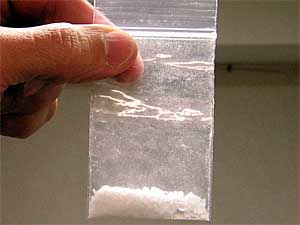-
- New Hampshire’s 100-year-old Church of the Redeemer closes
- State appeals court upholds domestic partner law
- Distraught at meth epidemic, gay activists mobilize to make a deadly drug ‘uncool’
- Former Boy Scouts of America official pleads guilty in porn case
- Task force releases report on economic benefits of marriage
- Simon & Schuster to publish Mary Cheney’s memoir
- National News Briefs
- World News Briefs
san diego
Call for community participation in combating crystal meth
Community health forum discusses methamphetamine, HIV infection and sex addiction
Published Thursday, 07-Apr-2005 in issue 902
San Diego County Heath and Human Services held an informational community forum on methamphetamine use and HIV infection March 28 at the Rosecrans Health Services Complex that featured a candid, down-to-earth discussion about links between methamphetamine addiction and HIV infection by Dr. Neva Chauppette, a Los Angeles-based licensed psychologist who specializes in methamphetamine’s links to HIV.
Chauppette detailed the issues surrounding meth addiction and the various factors that contribute to perpetuating the addiction, as well as the unsafe sexual compulsive behavior associated with it.
“I think we’re moving in the wrong direction because of methamphetamine, Viagra, Cialis and Levitra and sex addiction,” she said. “The three – of their own strengths – just coalesce and merge into this bullet, so to speak, that has brought this epidemic to another wave of crisis.”
Chauppette said sex addiction and methamphetamine use go hand-in-hand, and the community’s healthcare providers need to take action in order to address the problem and completely understand it.
“This is the drug of choice if you are burdened with sex addiction. At least in L.A., we don’t do a great job, in my opinion, recognizing, addressing or fighting sex addiction, and until we do that, I don’t think we are going to get a handle on HIV, particularly now in the context of this particular drug,” she said.
She also discussed the different types of meth, various drug paraphernalia, and the specific behaviors of addicts while under the influence of meth.
“This is a hyper-sexual drug to the point where it’s ‘scandalust’ with a T on the end of it. That’s the kind of behavior associated with this drug. The sexual problem, as you know, is only a piece of the problem in terms of HIV disease propagation,” she said.
Chauppette also mentioned how addicts commonly dilute meth down to a solution with water, draw it up in a syringe, break the needle off and squirt the solution into the rectum in a practice called “booty bumps,” which can increase possibility of STD infections, specifically HIV.
Chauppette believes meth abuse in the GLBT community may be a vehicle to cope with internalized homophobia, thus neutralizing negative internal dynamics associated with gay sexuality.
“I think if we’re ever going to take a look seriously at why the drug use problem and the domestic violence problem and the HIV epidemic continues to flourish in the gay and bisexual and lesbian community, we’re going to have to take a look at internalized homophobia,” she said.
The floor was opened at the end of Chauppette’s presentation for the audience to come up with ideas and strategies on how to combat the methamphetamine problem in the community. Some of the ideas put forth included increased training for providers on the complex nature of sexual addiction, and ideas to create more effective harm-reduction strategies as well as collaborating to provide another meth forum that would include more of the public rather than just addiction and recovery providers.
Earlier in the forum, Jim Zians, project director of the Edge Research Study at UCSD, presented data from Stepping Stone’s Harm Reduction and Social Marketing Campaign for Methamphetamine Abuse, conducted in the summer of 2003.
Full-color advertisements were put in newspapers, on billboards, and other visible areas to target gay and bisexual men in central San Diego. Educational pamphlets concerning meth abuse were distributed in bars, clubs and coffee shops, and random-catch sample surveys were conducted.
“It was a social marketing campaign that didn’t say, ‘Stop using meth’ or, ‘You have to use a condom.’ It basically was focusing on realistic, incremental changes that would maximize health behaviors,” Zians said.
He highlighted some key findings from the study, including the fact that those who use meth were less likely to practice safe sex. In terms of sex practices, HIV-negative and HIV-positive respondents said they both practiced unsafe sex at about the same rate.
The study revealed the top two recreational drugs used in the past two months were marijuana (30.9 percent) and meth (13.9 percent). Respondents who had used meth were significantly more likely to have seen the campaign’s ads. In addition, those who reported that they were HIV-positive rated the severity of the meth problem in the GLBT community higher than those who reported they were HIV-negative.
Zians addressed the complex and ever-changing problem of drug addiction.
“As public health people we have to meet people where they are in the culture and try to minimize change as much as possible for the maximum health benefits,” he said. “We have our challenges ahead of us.”
According to data compiled by STD Control Officer Dr. Robert Gunn, gay men who use meth are up to three times more likely to test positive for HIV as those who do not use meth. Thirty percent of people newly testing positive for HIV had used meth in the last six months. Also, in county-funded HIV prevention programs during fiscal year 2003-2004, 24 to 37 percent of clients reported meth use.
Gunn’s data also highlighted that meth users commonly use Viagra to counteract the erectile problems caused by the drug, and that mixing the two can lead to heart attacks and/or death.
|
|
Copyright © 2003-2025 Uptown Publications


